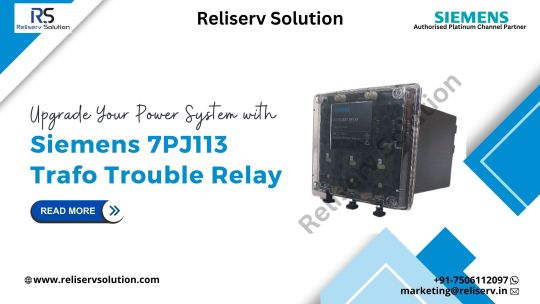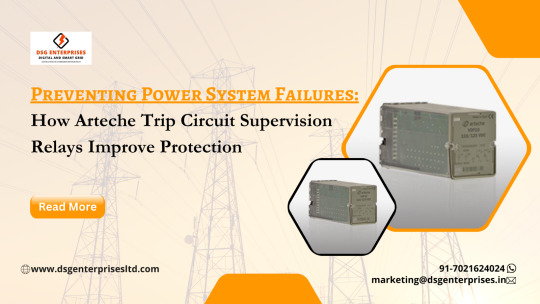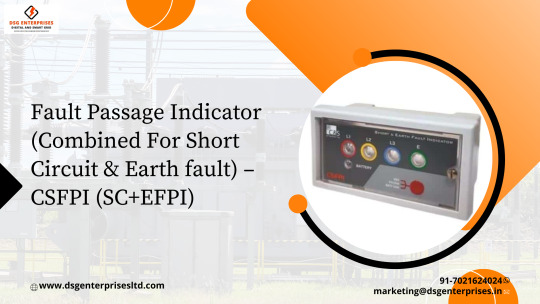#FaultDetection
Explore tagged Tumblr posts
Text
Differential Relay in Transformer: A Complete Guide
The differential relay in transformer is a crucial component in modern electrical systems. It protects the transformer by detecting internal faults like winding short circuits or insulation failures. This relay compares the current at the primary and secondary ends of a transformer. If there's any imbalance, it trips the breaker to avoid damage.

Differential Relay in Transformer: A Complete Guide This guide explains what a differential relay in transformer does, why it might trip, how it compares with other relays, and what happens during CT saturation. We'll also touch on related concepts like differential thermal overload relay and differential control. Relevant keywords like PI Test of Transformer and Fault Current Distribution in Star Delta Transformer are naturally included to enhance topic depth.
What Does a Differential Relay in Transformer Do?
A differential relay in transformer detects internal faults by measuring the difference in current between its two ends. It uses the principle that under normal conditions, the incoming and outgoing currents are nearly equal. Any significant difference implies current leakage due to internal faults. Here’s a breakdown of its core function: FeaturePurposeMonitors CurrentCompares primary and secondary currentsDetects Internal FaultsIdentifies short circuits and insulation breakdownFast ResponseTrips within millisecondsUses CTsOperates with Current Transformers for accurate comparisonWide Fault CoverageDetects ground, phase-to-phase, and turn-to-turn faults In short, the differential relay in transformer acts like a smart sensor and first responder rolled into one.
How Does a Differential Relay in Transformer Work?
Current Transformers (CTs) are installed on both sides of the power transformer. These CTs measure the current on both ends and send it to the differential relay. If the current on one end differs from the other beyond a set limit, the relay operates. During normal operation and external faults, the currents match when adjusted for transformer ratios. But when there's an internal issue, the difference (also called differential current) exceeds a threshold. Equation for Differential Current: Differential Current = IPrimary – ISecondary (after turns ratio compensation) If the differential current exceeds the setting, the relay sends a trip signal to the circuit breaker. This method ensures fast and selective tripping, minimizing damage and increasing transformer reliability.
What Causes a Differential Relay in Transformer to Trip?
Multiple factors can cause a differential relay in transformer to trip: - 1. Internal short circuits – Between windings or to ground - 2. Turn-to-turn faults – Within the same winding - 3. CT Saturation – Distorts the current measurement - 4. Incorrect CT polarity or mismatch – Leads to false differential current 5. - Inrush current during energization – High magnetizing current might resemble a fault - 6. Overfluxing or core saturation – Causes abnormal current waveforms These scenarios result in current imbalance, and if not filtered out properly, can lead to unwanted tripping.#DifferentialRelay, #TransformerProtection, #ElectricalEngineering, #PowerTransformer, #RelaySettings, #TransformerRelay, #CurrentProtection, #DifferentialProtection, #TransformerFaults, #ElectricalSafety, #PowerSystemProtection, #TransformerTesting, #ProtectiveRelays, #SubstationEquipment, #ElectricalRelays Read the full article
#DifferentialRelay#ElectricalRelays#ElectricalSafety#EngineeringConcepts#FaultDetection#PowerSystems#ProtectiveDevices#RelaySettings#SubstationEquipment#TransformerProtection
0 notes
Text

The GE MiCOM P444 Agile Distance Protection System is a high-performance numerical relay designed for fast, reliable, and flexible protection of transmission and sub-transmission lines. Built on the MiCOM P40 platform, the P444 offers six-zone distance protection, directional earth fault (DEF) detection, and comprehensive backup protection. With support for IEC 61850 digital substations, advanced cybersecurity features, and a robust fault locator, this relay ensures enhanced grid stability and reduced downtime for utility providers.
#MiCOMP444#DistanceProtection#PowerGrid#TransmissionLines#ElectricalProtection#NumericalRelay#SmartGrid#IEC61850#SubstationAutomation#EnergyReliability#GridStability#CyberSecurity#FaultDetection#GEProtection#PowerSystem
0 notes
Text


Earth Leak Relay offers multiple features that safeguards the circuits. Beemet with years of experience has been providing the best quality Earth Leak Relay for years. Visit our webpage to know more.
0 notes
Text
que odioso m pongo d berdat kuando beo k alguien a kien(exklusivamente)le he dedikado tantos meses d mi bida no dise ni una palabra k no involukre "kulparse d todo" o reseñar las pelis kon las k se identifika en leterbox.
pork klaro el k ha echo todo mal soi yo, tonses namas tengo k ponerm yo a pensar y a tratar d no suisidrme pnsando i eskribiendo por 8593 horas a la semana: komo solusionar lo k sea k ise👏👏.
chingadamadre otrabes yebo aki oras y yaa pta brga para eso es este blog, nimodo.
0 notes
Text

#siemens#auxiliary#TrafoTrouble#relay#powersystem#electricalengineering#energyefficiency#smartgrid#renewableenergy#powermanagement#industrialautomation#gridprotection#transformermaintenance#faultdetection#powerquality#digitalization#energysolutions#energymanagement
0 notes
Text
Importance of Stability Analysis in Feedback Control Systems: A Comprehensive Guide

In the intricate realm of engineering and automation, where precision and efficiency reign supreme, the significance of stability analysis in feedback control systems cannot be emphasized enough. From regulating the temperature in a chemical reactor to stabilizing the flight of an aircraft, feedback control systems play a vital role in ensuring optimal performance and safety across diverse industries. However, the effectiveness of these systems hinges upon their stability, making stability analysis a fundamental aspect of their design and implementation.
Feedback Control Systems:
At its core, a feedback control system comprises sensors, actuators, and controllers that work harmoniously to maintain desired outputs despite disturbances or uncertainties. The controller continuously adjusts the system’s inputs based on feedback from the sensors, aiming to minimize errors and maintain stability. But what exactly does stability entail in this context?
Stability and Feedback Control Systems:
In simple terms, stability refers to a control system’s ability to return to a desired state following perturbations or disturbances. For example, think of a thermostat maintaining room temperature: if it consistently overshoots or undershoots the setpoint, occupants would experience discomfort, highlighting the importance of stability in achieving reliable outcomes.
Stability analysis involves assessing a control system’s behavior under various conditions to determine its stability characteristics. This analysis typically involves mathematical modeling, simulation, and techniques such as root locus, Nyquist criterion, Bode plots, and frequency response analysis. By scrutinizing the system’s dynamics, engineers can identify potential instability issues and devise corrective measures to enhance performance and reliability.
So, why is stability analysis indispensable in the realm of feedback control systems?
Here are several compelling reasons:
1. Performance Optimization: - A stable control system exhibits predictable and consistent behavior, allowing engineers to fine-tune its parameters for optimal performance. - By analyzing stability margins and response characteristics, engineers can identify opportunities to enhance control system performance, such as reducing settling time, improving disturbance rejection, and minimizing overshoot.
2. Safety Assurance: - In safety-critical applications like nuclear reactors and autonomous vehicles, unstable control systems pose risks to human lives. - Stability analysis ensures the safety and reliability of these systems by preemptively identifying instability issues and implementing robust control strategies to mitigate risks.
3. Robustness Enhancement: - Real-world systems are often subject to uncertainties, nonlinearities, and external disturbances that can destabilize control loops. - Stability analysis allows engineers to assess control system robustness against uncertainties and design controllers capable of maintaining stability across a wide range of operating conditions.
4. Fault Diagnosis and Prevention: - Instabilities in control systems can arise from component failures, sensor inaccuracies, or environmental changes. - Monitoring stability over time enables engineers to detect anomalies indicative of potential faults or degradation, facilitating proactive maintenance and preventing catastrophic failures.
5. Cost and Time Savings: - Detecting and resolving stability issues early in the design phase can save significant time and resources by avoiding costly redesigns, reworks, and downtime associated with unstable control systems. - Thorough stability analysis upfront streamlines the development process, accelerates time-to-market, and enhances competitiveness.
Conclusion:
In conclusion, stability analysis is a cornerstone of effective feedback control system design and implementation. By rigorously examining stability characteristics, engineers can optimize performance, ensure safety, enhance robustness, facilitate fault diagnosis, and ultimately drive innovation across industries. As technology advances and demand for precise and reliable control systems grows, the importance of stability analysis remains unwavering, guiding engineers toward safer, more efficient, and more resilient solutions. If you want more articles related to these type of topic so visit here👉PujaControls
#automation#labview#plc#labviewsoftware#technology#software development#FeedbackControlSystems#StabilityAnalysis#IndustrialAutomation#EngineeringEfficiency#ControlSystemDesign#SafetyFirst#RobustControl#FaultDetection#OptimalPerformance#PrecisionEngineering
0 notes
Text
What role does AI play in optimizing cloud architecture?
AI plays a crucial role in optimizing cloud architecture by providing intelligent automation, resource management, and decision-making capabilities. Here are some key roles:
Resource Allocation and Scaling: AI algorithms can analyze usage patterns and automatically adjust resources to meet demand, optimizing performance and cost efficiency.
Predictive Analytics: AI enables predictive analytics to forecast future resource needs, allowing proactive adjustments to cloud infrastructure for better scalability and resource utilization.
Automated Provisioning: AI-driven automation can streamline the provisioning of resources, ensuring that the right amount of computing power, storage, and network resources are available on-demand.
Cost Optimization: AI helps in identifying cost-saving opportunities by analyzing usage patterns, suggesting reserved instances, and recommending strategies to minimize unnecessary expenses.
Security: AI can enhance cloud security by continuously monitoring and analyzing data for anomalies, detecting potential security threats, and implementing real-time responses to protect the cloud infrastructure.
Performance Optimization: AI algorithms can analyze performance metrics and make real-time adjustments to enhance application and system performance, ensuring a smooth user experience.
Fault Detection and Resolution: AI can detect anomalies and potential issues in the cloud environment, enabling automated responses or recommendations for resolution before they impact the system's reliability.
By incorporating AI into cloud architecture, organizations can achieve better efficiency, cost-effectiveness, and responsiveness, ultimately optimizing their overall cloud infrastructure.
#magistersign#onlinetraining#usa#support#CloudOptimization#AIinCloud#AutomatedManagement#CostEfficiency#CloudSecurity#ResourceScaling#PredictiveAnalytics#PerformanceEnhancement#FaultDetection#SmartCloudSystems
0 notes
Text
"Guardians of the Grid: Unleashing the Power of Medium Voltage Protection Relays 🛡️"
🌟 Trendy Title:Medium Voltage Protection Relays (MV) are the unsung heroes of modern electrical systems, ensuring the resilience and reliability of our power infrastructure.
These intelligent devices stand as vigilant sentinels, detecting and swiftly responding to anomalies like overcurrents, overvoltages, and short circuits, preventing potential damage and downtime. With advanced technology and adaptive algorithms, MV relays optimize grid performance, enhancing stability and efficiency in the face of evolving energy demands and environmental challenges. As industries embrace the transition to smarter, more resilient grids, MV protection relays play a pivotal role in safeguarding our energy future. #MediumVoltage #ProtectionRelays #GridResilience #ElectricalEngineering #EnergyInfrastructure #SmartGrid #PowerProtection #Reliability #FaultDetection #GridSecurity #EnergyManagement #ResilientInfrastructure #Innovation #SustainableEnergy #PowerGrid
0 notes
Text
Finding the Perfect Fit: Choosing the Most Suitable Relays for Different Power Grid Applications
In power grids, relays play a crucial role in protecting electrical systems from faults and ensuring their reliable and safe operation. However, selecting the right relays for specific applications can be a complex task. In this post, we will explore key factors to consider and provide guidance for choosing the most suitable relays based on specific power grid applications.
1. Overcurrent Protection:
Overcurrent events can occur due to various reasons, like short circuits or equipment malfunctions. To protect against these events, overcurrent relays are essential. When selecting overcurrent relays, consider the expected load current magnitude, fault current levels, and coordination with upstream and downstream protective devices.
2. Distance Protection:
Distance relays are used to protect transmission lines by measuring the impedance between the relay location and the fault location. Factors to consider when selecting distance relays include fault location accuracy, fault resistance detection capability, and speed of operation.
3. Differential Protection:
Differential relays compare current inputs on both sides of a protective zone to detect internal faults within transformers, generators, or busbars. Considerations when choosing differential relays include sensitivity requirements, operating characteristics (adaptive or fixed), and communication capabilities.
4. Generator Protection:
Generators are critical components of power grids, and protecting them from faults is essential. When choosing relays for generator protection, parameters such as stator winding faults, rotor faults, loss of excitation, and loss of synchronization must be taken into account.
5. Transformer Protection:
Transformers are vital for voltage conversion and supply stability. Transformer protection relies on various aspects such as overcurrent protection, differential protection, backup protection schemes, and thermal protection to safeguard against faults.
6. Motor Protection:
Motors are key elements that drive industrial processes, and their protection is critical for uninterrupted operations. Motor protection relays should consider factors like overload protection, phase asymmetry, locked rotor detection, and thermal model-based protection.
Conclusion:
Selecting the most suitable relays for specific power grid applications requires careful analysis of various aspects, including fault types, system topology, coordination requirements, and desired response times. It is essential to consult with experts, refer to industry standards, and leverage the experience of relay manufacturers to ensure the optimal selection for a reliable and effective protection scheme. By considering these factors, power grid operators can enhance the safety and stability of their systems.
Remember, every power grid is unique, so it's crucial to tailor the selection of relays to the specific needs and characteristics of your own system.
#PowerGrid #RelaySelection #ElectricalProtection #OvercurrentProtection #DistanceProtection #DifferentialProtection #GeneratorProtection #TransformerProtection #MotorProtection #FaultDetection
0 notes
Text
Fault Current and Short Circuit Current: A Quick Guide
Understanding fault current and short circuit current is essential in electrical power systems. These terms are critical in designing safe and reliable networks. While they are often used interchangeably, they have nuanced differences. Knowing how to calculate, manage, and limit these currents helps protect electrical equipment and personnel. This article will explore these concepts in detail. It will also include technical insights and formulas.

Fault Current and Short Circuit Current
What is Fault Current and Short Circuit Current
Fault current and short circuit current refer to the sudden surge of electric current caused by an unintended path in an electrical circuit. This path can be due to equipment failure, insulation breakdown, or accidental contact between conductors. When this happens, the resistance in the circuit drops drastically. As a result, the current shoots up to very high levels. In simple terms, short circuit current is a type of fault current that flows when two points in a circuit that should not be directly connected come into contact. This results in very high current flowing almost instantly.
Types of Faults Leading to Fault Current and Short Circuit Current
Several types of faults can cause high currents in a system. These faults vary in nature and impact: Line-to-Line Fault This happens when two phases come in contact. Line-to-Ground Fault Occurs when one phase touches the ground or any grounded object. Three-Phase Fault This is the most severe fault and involves all three phases shorting together. Line-to-Line-to-Ground Fault A combination of the above types. Each of these faults generates different levels of fault current and short circuit current depending on the system's configuration. Read More..... #FaultCurrent, #ShortCircuitCurrent, #ElectricalEngineering, #PowerSystemProtection, #CircuitBreaker, #CurrentLimiting, #ElectricalSafety, #ElectricalFaults, #ShortCircuitAnalysis, #FaultDetection, #PowerSystems, #ElectricalDesign, #HighCurrentFaults, #ProtectiveRelays, #IndustrialElectrical Read the full article
#CircuitBreakers#CurrentAnalysis#ElectricalEngineeringConcepts#ElectricalFaults#FaultCurrent#IndustrialSystems#PowerSystems#ProtectionDevices#SafetyStandards#ShortCircuitCurrent
0 notes
Text
Arteche Relays for Error-Free Operation: Protecting Power Transformers and Circuit Breakers

In the high-stakes world of power systems, ensuring the safety and reliability of critical equipment is paramount. Power transformers and circuit breakers form the backbone of electrical infrastructure, handling massive loads and enabling smooth power distribution. However, these vital components are susceptible to faults, overloading, and other hazards. Arteche relays, particularly their trip and lockout relays, have become a trusted solution to safeguard such equipment, offering reliability, speed, and durability in demanding environments.
The Role of Relays in Power Systems
Relays serve as protective devices in electrical circuits, detecting anomalies such as overcurrent, short circuits, and other fault conditions. When an issue is detected, relays promptly isolate the affected section to prevent further damage. This protective mechanism is critical for power transformers and circuit breakers, as failures in these systems can lead to costly repairs, extended downtime, and potential safety hazards.
Arteche, a globally recognized leader in relay manufacturing, has been at the forefront of developing high-performance relays for over 60 years. Their trip and lockout relays are specifically designed to meet the rigorous demands of modern power systems, ensuring error-free operation and long-term reliability.
Arteche’s Trip and Lockout Relays: Key Features
Arteche’s trip and lockout relays are purpose-built for high-voltage environments, such as substations, power generation plants, and industrial facilities. Here are some standout features that make these relays indispensable:
High-Speed Operation
Arteche relays boast a rapid response time, typically between 3 and 20 milliseconds, depending on the model. This swift action minimizes the risk of cascading failures and ensures that faults are isolated before they can escalate.
Latching Mechanism
The latching design of Arteche’s lockout relays (LOR - ANSI 86) ensures that once a trip occurs, the relay remains in a locked position until it is manually or electrically reset. This feature prevents inadvertent re-energization of faulty equipment, enhancing overall safety.
High Breaking Capacity
Arteche relays are engineered to handle high fault currents without compromising performance. Their robust construction guarantees reliable operation even under extreme fault conditions.
Compliance with International Standards
Arteche relays meet stringent standards such as IEC 61000, IEC 60947, IEC 60255, and ANSI C37.90. This compliance ensures compatibility and reliability across diverse power systems worldwide.
Wide Voltage Range
Arteche offers relays with a broad spectrum of auxiliary voltage options, making them suitable for various applications and environments.
Durability in Harsh Environments
Designed to withstand seismic conditions, vibrations, and extreme temperatures, Arteche relays are ideal for deployment in demanding operational environments.
Protecting Power Transformers
Power transformers are crucial for voltage regulation and power transmission in electrical grids. They operate under high stress and are prone to issues like overheating, oil leaks, and insulation failures. Arteche relays provide several layers of protection for transformers:
Fault Isolation: Arteche’s trip relays rapidly disconnect transformers from the grid in case of overcurrent or short circuits, preventing further damage.
Preventing Re-Energization: The lockout feature ensures that a transformer cannot be re-energized until the fault is rectified and the relay is manually reset. This eliminates the risk of additional damage from unresolved issues.
Monitoring Critical Parameters: Arteche relays integrate seamlessly with monitoring systems, enabling real-time tracking of key transformer parameters like temperature, gas pressure, and oil levels. This proactive approach enhances reliability and reduces maintenance costs.
Enhancing Circuit Breaker Reliability
Circuit breakers play a pivotal role in interrupting fault currents and protecting electrical circuits. Arteche relays enhance their operation in several ways:
Precise Command and Control: Arteche’s high-speed relays ensure that circuit breakers receive accurate and timely trip commands, minimizing response times during fault conditions.
Long Wiring Support: The high-burden configuration of Arteche relays prevents false trips caused by transient signals or long wiring distances. This feature is particularly beneficial in large substations where relay-to-breaker connections can span significant distances.
Durability and Longevity: Arteche’s relays are built to last, ensuring consistent performance over decades of operation. Their robust design minimizes the risk of relay failure, which could otherwise compromise circuit breaker functionality.
Meeting the Demands of High-Voltage Substations
High-voltage substations are complex environments where reliability and safety are non-negotiable. Arteche’s relays are specifically designed to address the challenges of such settings:
Handling High Fault Currents: Arteche relays are equipped to manage the high fault currents typical of HV substations, ensuring seamless operation during fault conditions.
Seismic and Vibration Resistance: Arteche relays are tested to withstand seismic activity and mechanical vibrations, making them suitable for installations in earthquake-prone regions.
Error-Free Operation Under Transients: Arteche’s compliance with ESI 48-4 standards ensures that their relays operate reliably even under transient conditions, minimizing the risk of nuisance trips.
Arteche’s Legacy of Excellence

With over six decades of experience, Arteche has earned a reputation for producing high-quality electromechanical relays. Millions of their relays are in service worldwide, safeguarding critical power equipment in diverse applications. Here are some reasons why Arteche continues to lead the industry:
Uncompromising Quality: Arteche’s relays undergo rigorous testing to ensure they meet the highest standards of performance and reliability.
Innovative Designs: Arteche’s commitment to innovation is evident in features like high-speed operation, latching mechanisms, and high-burden configurations.
Global Reach: Arteche’s relays are trusted by utilities, industrial plants, and power generation facilities across the globe, thanks to their adaptability and compliance with international standards.
Case Studies: Arteche Relays in Action
Substation Safety in Europe: A high-voltage substation in Europe implemented Arteche trip and lockout relays to enhance equipment safety. The relays’ rapid response and high-breaking capacity significantly reduced downtime during fault incidents, saving the utility millions in repair costs.
Transformer Protection in Asia: A power generation company in Asia relied on Arteche relays to protect its fleet of transformers. The relays’ real-time monitoring capabilities helped identify potential issues before they escalated, improving overall system reliability.
Industrial Facility in North America: An industrial plant in North America integrated Arteche relays into its control systems to ensure seamless operation of circuit breakers. The relays’ durability and precision were key factors in minimizing production losses due to electrical faults.
Conclusion
Arteche relays are a cornerstone of modern power systems, offering unmatched reliability, speed, and durability. Their ability to protect vital equipment like power transformers and circuit breakers ensures that electrical grids and industrial facilities operate smoothly and safely. Whether it’s preventing the re-energization of faulty equipment, handling high fault currents, or enduring harsh environmental conditions, Arteche’s trip and lockout relays consistently deliver error-free performance.
For power systems where safety and reliability are paramount, Arteche relays provide the peace of mind that comes with over 60 years of engineering excellence. As the demands on power infrastructure continue to grow, Arteche remains a trusted partner in safeguarding the critical components that keep the lights on and the world running.
At Digital & Smart Grid Enterprises, we pride ourselves on delivering cutting-edge solutions, including reliable Arteche relays, to ensure the safety and operational efficiency of your power systems. Our expertise spans comprehensive testing, commissioning, and monitoring services tailored to safeguard your critical power equipment, such as power transformers and circuit breakers.Contact us today at +917021624024 or email [email protected] to learn more about how we can support your power system's reliability and safety. Click here to explore our Relay Protection and Maintenance Services.
#PowerSystemSafety#ElectricalInfrastructure#ArtecheRelays#TransformerProtection#CircuitBreakerReliability#HighVoltageSolutions#RelayProtection#EnergyEfficiency#ElectricalSafety#SubstationAutomation#IndustrialPowerSolutions#FaultDetection#GridReliability#ElectricalEngineering#SmartGridSolutions
0 notes
Video
instagram
. با استفاده از کلید آشکار ساز زود هنگام آرک ( جرقه ) Arc fault detector میتوانید از بروز %90 از آتش سوزی های ناشی از جرقه الکتریکی در ساختمان ها جلو گیری کنید. @DGminer #dgminer #asicminer #asicmaintenance #asic #cryptominingfarm #cryptominingfarm #cryptomining #bitcoinmining #faultdetection #arc_fault #دیجیماینر #دیجی_ماینر #استخراج_ارز_دیجیتال #ارزدیجیتال #ارزدیجیتالی #ایسیک_ماینر #ایسیک #ایسیک_بوست #بیتکوین #بیتکوین_ماینر (at Tehran, Iran) https://www.instagram.com/p/BysArZCnQU6/?igshid=cjr5391oe41g
#dgminer#asicminer#asicmaintenance#asic#cryptominingfarm#cryptomining#bitcoinmining#faultdetection#arc_fault#دیجیماینر#دیجی_ماینر#استخراج_ارز_دیجیتال#ارزدیجیتال#ارزدیجیتالی#ایسیک_ماینر#ایسیک#ایسیک_بوست#بیتکوین#بیتکوین_ماینر
0 notes
Text

The GE MiCOM P343 relay is a powerful, all-in-one solution for protecting medium to large generators and transformers. Designed to ensure fast and selective tripping for phase and earth faults, the P343 relay provides an extensive range of protective features, including sensitive rotor earth fault detection, 100% stator earth fault protection, and overload monitoring. Equipped with flexible communication protocols and a user-friendly programmable logic interface, the MiCOM P343 helps facilities maintain consistent generator performance, reduce downtime, and enhance overall safety. Whether facing corrosive environments or complex protection needs, this versatile relay solution ensures that generators and transformers are thoroughly protected and monitored.
#generatorprotection#TransformerSafety#geprotectionrelay#MiCOMP343#electricalsafety#PowerSystemProtection#industrialsafety#EnergyReliability#electricalengineering#FaultDetection#conditionmonitoring#smartgridsolutions#AutomationInEnergy#powersystems#energymanagement
0 notes
Text
Preventing Power System Failures: How Arteche Trip Circuit Supervision Relays Improve Protection

In the modern power industry, reliability and protection are essential to ensuring smooth operations. Electrical systems are intricate, and any failure can lead to significant losses, both operationally and financially. One critical aspect of these systems is the trip circuit, which plays a vital role in the safe disconnection of faulty components. The Arteche VDF-10 Trip Circuit Supervision Relay and other Arteche supervision relays are designed to ensure that trip circuits remain reliable and functional, preventing system failures and enhancing protection.
In this blog, we will explore how Arteche’s supervision relays help prevent power system failures, their essential role in maintaining safety, and why they are critical for the protection of modern electrical infrastructures.
Understanding Trip Circuits and Their Importance
In power systems, trip circuits are part of the protective relaying scheme. When a fault occurs, such as a short circuit or overload, the trip circuit activates the circuit breaker, which disconnects the faulty part from the system to prevent damage or failure. Essentially, trip circuits are the backbone of system protection, as they ensure that the system responds appropriately to any malfunction.
However, trip circuits can sometimes fail due to wiring issues, mechanical faults, or component deterioration. If a trip circuit fails, the breaker may not operate when required, leaving the system vulnerable to extensive damage. Therefore, monitoring and ensuring the health of trip circuits is critical, and this is where Arteche VDF-10 Trip Circuit Supervision Relays come into play.
What is the Arteche VDF-10 Trip Circuit Supervision Relay?
The Arteche VDF-10 Trip Circuit Supervision Relay is a specialized device designed to continuously monitor the integrity of trip circuits in electrical systems. It ensures that the trip circuit is always operational, providing real-time supervision and instant detection of any faults.
Some key features of the Arteche VDF-10 include:
Continuous Supervision: The VDF-10 continuously monitors the trip circuit, detecting wiring faults, open circuits, or component failures.
Instant Alerts: If any malfunction occurs in the trip circuit, the relay sends an immediate alarm to alert the maintenance team of the issue.
Compact Design: The VDF-10 is designed to fit into compact spaces within substations and other electrical environments.
Versatility: It can be used in a wide range of voltage systems, making it applicable across different power system configurations.
By using the Arteche Relay, operators can detect potential issues early, before they cause system failures, and take preventive measures to maintain uninterrupted operations.
How Arteche Trip Circuit Supervision Relays Improve Protection
Let’s dive deeper into how Arteche trip circuit supervision relays, such as the VDF-10, contribute to the protection and reliability of power systems:
1. Real-Time Monitoring for Early Fault Detection
One of the biggest challenges in power systems is identifying problems before they escalate into full-scale failures. The Arteche VDF-10 Trip Circuit Supervision Relay continuously monitors the trip circuit in real-time, ensuring that the circuit is always functional. It checks for open circuits, wiring failures, loose connections, and other issues that may compromise the trip circuit’s ability to operate.
This real-time monitoring provides early detection of faults, allowing maintenance teams to address the problem before it leads to a critical failure. By proactively identifying issues, the VDF-10 prevents costly outages and reduces the risk of equipment damage.
2. Enhanced System Reliability
The reliability of the trip circuit directly impacts the reliability of the entire electrical system. When a fault occurs in the power network, the trip circuit must operate swiftly to disconnect the faulty section and protect the rest of the system. A malfunctioning trip circuit could lead to a delay in the breaker operation, resulting in extensive damage and prolonged downtime.
The Arteche VDF-10 Trip Relay enhances system reliability by ensuring that the trip circuit is always in good working order. By providing constant supervision, it ensures that power systems can respond promptly to any fault, improving overall reliability and system uptime.
3. Prevention of Catastrophic Failures
In the absence of trip circuit supervision, undetected faults can accumulate over time, increasing the risk of catastrophic system failures. A simple wiring issue in the trip circuit could prevent the breaker from disconnecting a faulty part, leading to large-scale damage to transformers, generators, and other critical equipment.
Arteche’s trip circuit supervision relays, like the VDF-10, prevent such failures by offering continuous supervision and immediate alerts. By ensuring that the trip circuit functions as intended, Arteche supervision relays safeguard electrical equipment and prevent failures that could lead to costly repairs or replacements.
4. Reduction of Maintenance Downtime
In traditional power systems, maintenance teams often conduct periodic manual checks to ensure the integrity of trip circuits. However, this process is time-consuming and prone to human error. By using Arteche VDF-10 Trip Circuit Supervision Relays, operators can automate the supervision process and receive alerts in real-time when a fault occurs.
This real-time fault detection reduces the need for manual inspections and allows maintenance teams to focus on addressing actual issues rather than spending time on routine checks. As a result, the system experiences less maintenance downtime, improving operational efficiency.
5. Improved Safety for Operators and Equipment
Electrical systems can be hazardous, and faults that go undetected in trip circuits can pose serious safety risks to operators. Without proper trip circuit supervision, an operator might unknowingly engage with a faulty system, leading to injury or damage.
Arteche trip circuit supervision relays improve safety by ensuring that operators are informed of any issues in the trip circuit before they interact with the system. Immediate alerts and fault detection give operators the necessary information to act safely, preventing accidents and protecting both personnel and equipment.
Arteche Supervision Relays: A Broader Perspective
While the Arteche VDF-10 Trip Relay plays a specific role in monitoring trip circuits, Arteche also offers a wide range of supervision relays designed to enhance the protection and functionality of electrical systems. These relays are used to monitor critical parameters such as voltage, current, and circuit continuity, ensuring that power systems operate efficiently and safely.
Arteche’s supervision relays are known for their reliability, ease of use, and versatility. They can be integrated into various power system configurations, making them suitable for substations, power plants, industrial facilities, and other electrical infrastructures.
Conclusion
In today’s highly interconnected and complex power systems, ensuring the reliability and functionality of trip circuits is essential for preventing system failures. The Arteche VDF-10 Trip Circuit Supervision Relay and other Arteche supervision relays offer a proactive solution to monitoring and protecting trip circuits, ensuring that electrical systems can respond swiftly to faults and maintain uninterrupted operations.
By providing real-time monitoring, early fault detection, and enhanced protection, Arteche’s supervision relays improve the safety, reliability, and efficiency of power systems. For operators seeking to prevent catastrophic failures and enhance system reliability, the Arteche Trip Circuit Supervision Relay is an indispensable tool.
At Digital & Smart Grid Enterprises, we are committed to providing industry-leading supervision relay solutions, including the reliable Arteche VDF-10 Trip Relay. Our team of experts specializes in ensuring the safety and operational efficiency of your power systems through comprehensive testing, commissioning, and monitoring services. Whether it’s enhancing the reliability of your trip circuits or safeguarding your infrastructure against potential faults, we utilize advanced diagnostic tools to deliver precise and dependable results.
Contact us today at +917021624024 or email [email protected] to learn how we can help you protect and optimize your electrical systems.Click here to explore our Supervision Relay Services.
#powersystems#ElectricalEngineering#ReliabilityEngineering#CircuitProtection#TripCircuit#SupervisionRelay#Arteche#PowerGrid#ElectricalSafety#FaultDetection#SmartGrid#IndustrialAutomation#MaintenanceEfficiency#ElectricalInfrastructure#EnergyManagement
0 notes
Text

The Schneider Easergy P3F30 Feeder Protection Relay offers advanced protection for electrical distribution networks, ensuring reliable operation and safety. With its precise fault detection capabilities and customizable settings, it provides optimal protection for feeder circuits, enhancing system resilience and efficiency.
C𝐨𝐧𝐭𝐚𝐜𝐭 𝐮𝐬 𝐨𝐧 +91 7021624024 𝐨𝐫 𝐠𝐞𝐭 𝐢𝐧 𝐭𝐨𝐮𝐜𝐡 𝐰𝐢𝐭𝐡 𝐮𝐬 𝐚𝐭 [email protected]
#schneidereasergy#p3f30#feederprotection#relay#electricalsafety#powerdistribution#energyefficiency#faultdetection#systemresilience#electrician#smartgrid#powersystems#gridprotection#industrialautomation#reliabletechnology
0 notes
Text

Fault Passage Indicator for Earth, is engineered to identify and signal Earth faults within a cable system, specifically in RMU networks configured with a single input or an open ring arrangement. When the current surpasses predetermined trip settings, the unit promptly signals a fault condition. The detection of fault current is facilitated by a sensor mounted on the cable, which then transmits a signal to the indication unit.
𝐂𝐨𝐧𝐭𝐚𝐜𝐭 𝐮𝐬 𝐨𝐧 +91 7021624024 𝐨𝐫 𝐠𝐞𝐭 𝐢𝐧 𝐭𝐨𝐮𝐜𝐡 𝐰𝐢𝐭𝐡 𝐮𝐬 𝐚𝐭 [email protected]
#faultpassageindicator#shortcircuit#earthfault#csfpi#scefpi#electricalsafety#faultdetection#cablemanagement#powerdistribution#safetysystem#industrialautomation#energyefficiency#powergrid#utilities
0 notes